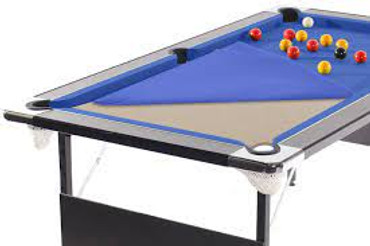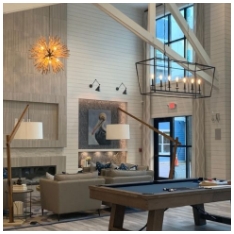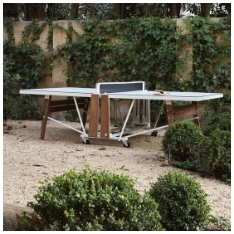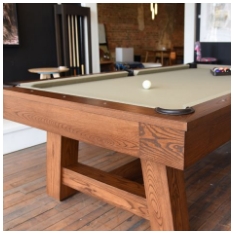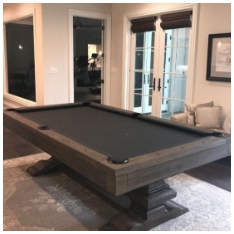When shopping for a pool table, one of the most important decisions you'll face is choosing between MDF and slate. Each has its own strengths and limitations, and your choice can significantly affect gameplay, durability, cost, and maintenance.
This guide will help you understand the key differences between MDF and slate pool tables so you can make an informed choice that suits your needs and budget.
What Are MDF and Slate Pool Tables?
MDF (Medium Density Fiberboard) Pool Tables
MDF pool tables use a man-made wood composite as the base for the playing surface. This engineered material is made by compressing wood fibers with resin, resulting in a flat, stable surface. MDF is generally used in entry-level or recreational pool tables.
Slate Pool Tables
Slate pool tables feature a playing surface made from natural slate stone. Slate is widely considered the gold standard in billiards due to its stability and smoothness. Most professional or high-end tables are built with slate.
Key Differences Between MDF and Slate Pool Tables
1. Playing Surface and Performance
Slate:
Slate provides an exceptionally smooth and level playing field. The ball rolls accurately and consistently, making it ideal for serious or professional players. Slate tables are typically used in tournaments and pool halls.
MDF:
MDF can offer a reasonably smooth playing surface, but it doesn't match the precision or consistency of slate. Over time, MDF may warp slightly, especially in humid or fluctuating temperatures, which can affect the ball's movement.
Verdict: If performance and accuracy are top priorities, slate is the superior choice.
- Durability and Longevity
Slate:
Slate is extremely durable and can last decades when properly cared for. It is resistant to warping, moisture, and changes in temperature. A slate table often becomes a long-term investment.
MDF:
MDF is less durable and more susceptible to damage from humidity, temperature swings, and heavy use. Warping over time is a common issue, particularly if the table is placed in a non-climate-controlled environment like a garage or basement.
Verdict: Slate tables offer much greater durability and lifespan.
- Cost and Affordability
Slate:
Slate pool tables tend to be more expensive, both in terms of materials and shipping. Their weight and professional-grade components contribute to the higher cost.
MDF:
MDF tables are usually more affordable and are a popular option for casual players or those buying a table for family use. They offer a reasonable level of performance at a lower price point.
Verdict: MDF is the better option for budget-conscious buyers.
- Weight and Portability
Slate:
Slate is heavy. A single-piece slate table can weigh 500 pounds or more, while three-piece slate designs are even heavier. Once installed, it’s not easy to move the table without professional help.
MDF:
MDF tables are significantly lighter, making them easier to assemble, move, or relocate. This portability makes MDF tables a practical choice for renters or those planning to relocate frequently.
Verdict: MDF is ideal if you need a table that’s easier to move.
- Installation Requirements
Slate:
Installing a slate table usually requires professional assistance. The slate pieces must be leveled and joined precisely to ensure a flat playing surface.
MDF:
Most MDF tables come in a ready-to-assemble format and can be set up with basic tools. They are ideal for DIY installations.
Verdict: MDF tables are more convenient for self-installation.
- Maintenance and Care
Slate:
Slate itself doesn’t require much maintenance, but the felt and frame should be kept clean and in good condition. The weight and structure of slate tables also mean they require stable flooring and careful placement.
MDF:
MDF tables need protection from moisture. Spills, damp air, or poor ventilation can cause damage to the playing surface. Regular cleaning and humidity control are essential for extending the table’s life.
Verdict: Slate is more resilient and lower-maintenance in the long term.
Pros and Cons Summary
|
Feature |
MDF Pool Table |
Slate Pool Table |
|
Playing Quality |
Good for casual play |
Excellent for serious play |
|
Durability |
Moderate – prone to warping |
Very high – lasts decades |
|
Cost |
Affordable |
Expensive |
|
Weight |
Lightweight and portable |
Heavy and requires professional moving |
|
Setup |
DIY-friendly |
Needs professional setup |
|
Maintenance |
Needs careful care |
Low-maintenance playing surface |
Best Use Cases
Choose an MDF Pool Table If:
- You are a casual player or purchasing for family use
- You need an affordable table for a small space
- You plan to move homes in the near future
- You want a lightweight, easy-to-assemble option

Choose a Slate Pool Table If:
- You’re a serious or competitive player
- You want the best playing experience and ball accuracy
- You are looking for a long-term investment
- You have a dedicated game room with proper space and flooring
Consider the Environment
The room in which you plan to place your pool table should also influence your decision:
- Basement or Garage: Avoid MDF unless the room is climate-controlled. Slate is more stable in variable conditions.
- Apartment or Small Space: MDF’s lighter weight makes it easier to move and install.
- Dedicated Game Room: If you have the space and budget, a slate table adds long-term value.
Cost Over Time
While MDF tables have a lower upfront cost, they may need to be replaced sooner, especially if exposed to moisture or heavy wear. Slate tables, while more expensive initially, are highly durable and often retain value better over time.
If you see your pool table as a long-term feature in your home, slate could ultimately offer better value.
Conclusion
Both MDF and slate pool tables serve their purpose, but the right one for you depends on how you plan to use it, your budget, and the environment where it will be placed.
If you're after affordability and portability, MDF pool tables are a practical solution for recreational use.
If you prioritize performance, durability, and a premium playing experience, slate pool tables are the clear winner.
Make your decision based on how you plan to use the table, the space available, and whether you're investing for the short or long term.
